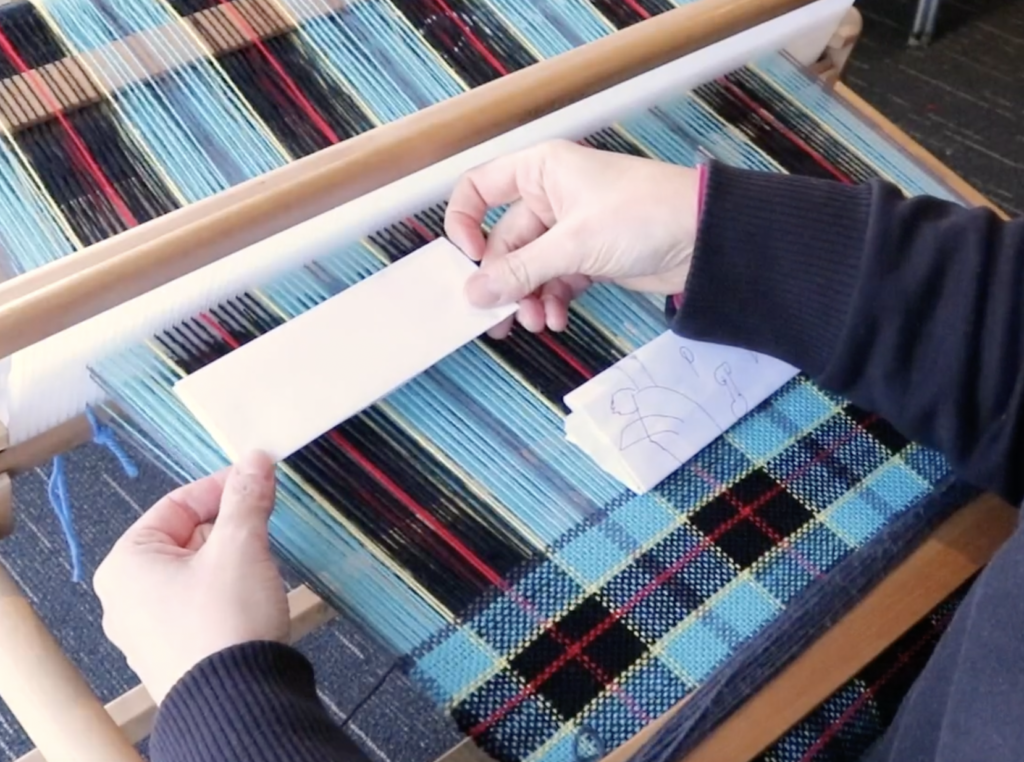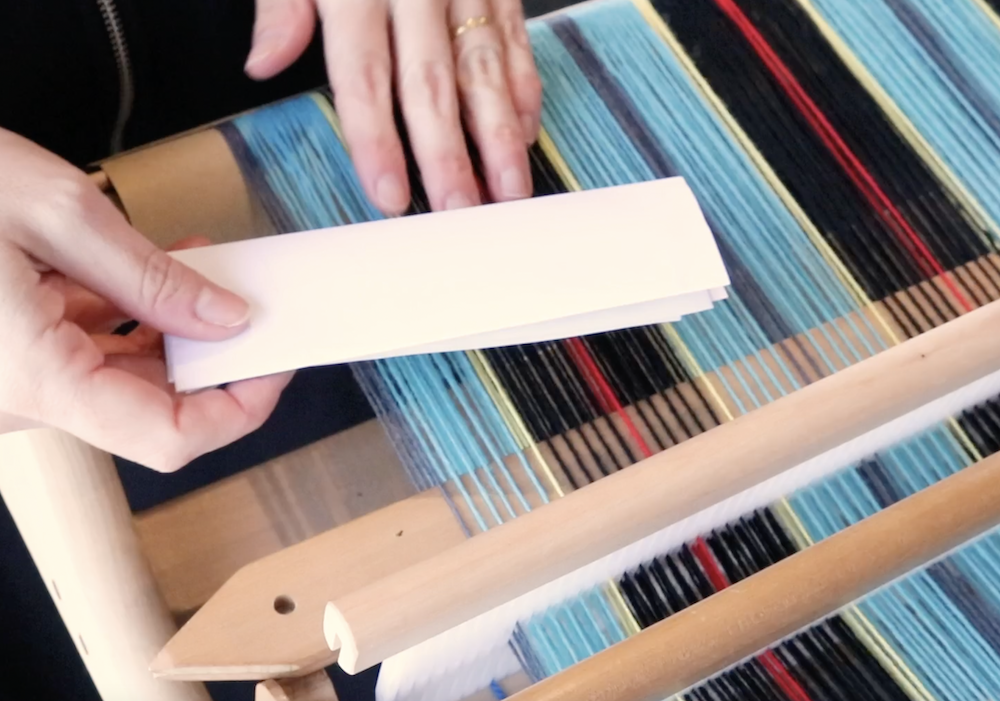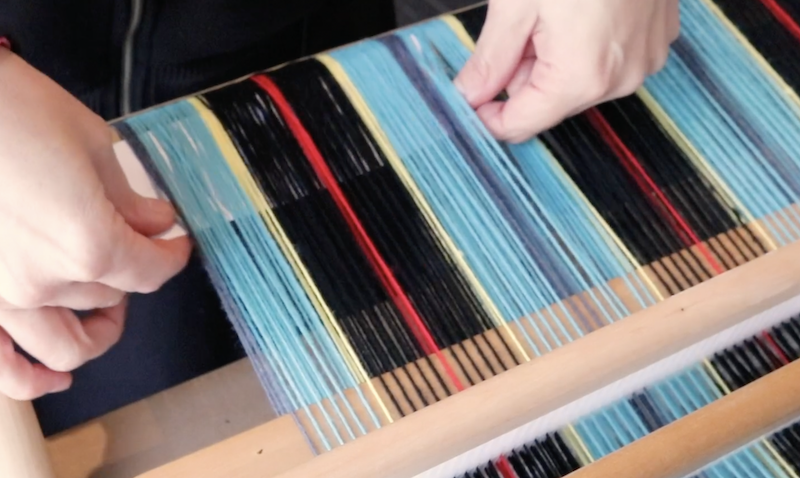In an ideal world we would have perfect tension every time we warp our looms, but that is just not realistic!
There are many challenges to achieving great warp tension, but the good news is that practice helps a lot and this is something you will improve on over time.
But, even for the seasoned weaver, there can be the occasional curve ball just to keep us humble 😆 For me, that was a recent double width project on my rigid heddle loom.
*This post contains affiliate links. For further information, see my disclosure policy.
I warped independently, which is do-able but not 100% ideal when you’re using thicker threads and those threads are doubled. When I started weaving, I found that my tension was firmer in the middle than on either side.
This began interfering with the “cleanness” of my sheds, meaning that not all my warp threads were settling into position well when I changes sheds. And for double width weaving, that can be a huge headache!
I’ve covered wedging before, as you can see in this video:
But I also wanted to get a bit more specific about wedging problem areas in your warp. This is very quick and easy to do and can make a big difference to your tension.
I start out by identifying the areas that need help. For me, that was either side of the middle section, towards the edges. If I wedges all the way across the warp at this point, that would also increase the tension in the mid section, where it is not needed.
There are several materials you can use for wedging (like cardboard separators, cut to size) but I chose to use everyday A4 printing paper. I folded the paper to the approximate width of the loose warp section so that the paper had been folded about 4 times. This provided me with a bit of thickness, but not too much.
It may be easiest for you to pop around the back of your loom with the paper to get close to the warp.
Take the paper underneath the entire warp (both heddles are in neutral at this point) and start to wiggle and jam it into place.
Push the paper in towards the back of the loom. You will feel resistance from the threads and this is good, because you are tightening everything up. There is no set amount for how far back the wedge should be pushed, just until you can feel that the threads have increased in tension in that section.
As you weave and advance your warp, your wedges will move out of place and you will need to reposition them at each advance. This is actually a good thing, because it ensures that your looser threads are constantly being re-tensioned!
If you would like to see the way I place the wedges, please check out this video:
I hope this short tutorial was useful to you! Have you used targeted wedging before? Has it made all the difference to your project? Let me know in the comments, I would love to hear from you!
Do you love the look of the project I’m working on in this tutorial? This is from my Plaid Double Width Blanket Ebooklet, which is available now.
Until next time…
Happy Weaving!








My problem is usually with just one or two threads so I have used a tiny ball of yarn beneath that thread. But once I had single threads in several places and had these little balls of yarn inserted across the back 9f the warp. I really appreciate this suggestion if I ever have an area of loose threads.
Hi Kelly can you please tell me if you used a computer program for the planning of this beautiful rug. I purchased the E Book today, I hope to start one in the new future as I have wonted to weave one put didn’t know were to start – as always a fantastic pattern and Ebook. I have now words of how beautiful it is.
I’m warping up my big Ridge Heedle tonight for some Tea Towel for gifts for Christmas as I have not recieved my wool for the Boot Camp, I will be doing the scarf on my 10in Sampet loom I think this will be wide enought,
Keep uo the great work and you are so supportive. I’m so happy to see you have your dream of a Homestead with your lovely family.
Thank you for the kind words Ann! I did use Weaveit Pro to layout the colour arrangements initially, and to tweak the design until I was happy with it. You could do the same on graph paper though, it just takes a little longer.
Yes, your Sampleit will be just fine for the scarf 😉
I have just finished a long (8 ft) table runner in log cabin. About half way along the right hand side of the warp started to feel looser than the left. I had warped with corrugated cardboard as packing, so I slipped a single pointed knitting needle under the first layer of the corrugated, just to the point where it needed tightening. It worked a treat – I slid it out when advancing the warp and slid it in again for weaving. Magically, after repeating this several times, the warp evened out and I no longer needed to make the adjustment.
Awesome Kathleen, great ingenuity!
Kelly, I realized what the problem was where I was placing my wedge. I have a Schacht flip loom and it’s designed with a bar in front of the back roller. Since then, I moved it to the back roller and it’s working! Thanks for your clarification, I never would have tried to analyze the placement until you said it shouldn’t move.
Oh, that’s terrific, I didn’t even consider different placement for different looms!
Great advice Kelly! This will be great to have in my arsenal of solutions to weaving issues.
Terrific, I’m glad it’s useful to you!
Great tip! I’ve actually done this quite a bit on my four harness loom. However, many times I’ll wedge them in on the cloth beam if I’m in between multiple projects on a single warp. This evens up the warp at the beginning of the next project. I know that’s not standard procedure, lol. What do you think?
Yes, definitely, I’ve done that myself too 😊
Kelly you are always so helpful! This has happened to me before and was rather frustrating. Such a simple fix and yet I have never thought of putting something in under sections of the warp rather than the whole warp. Still a newbie I guess. Thank you so much. I will definitely give this a try next time!
I hope it works well for you 😊
Talk about perfect timing! I’m struggling with this tension issue with the Log Cabin pattern. The yarn I used was Sharpies Cotton. While it was given as an alternative yarn to the one you used, it really is quite different and disappointing. As you suggested, I’ve been placing cut down pieces of cardboard in the middle sections. With the cardboard, my tension was greatly improved, however I struggle with the floats while weaving. As I continue with the pattern, carefully moving the shuddle through to avoid the floats, I find that the cardboard does move and eventually slips out. Mind you, its not because I advanced, but just with the movement back and forth with the shuddle. Should this being occurring or am I still not doing this correctly?
The wedges don’t usually move out of place unless you’re advancing the warp. Are you pushing them right under the whole warp, with the heddles in neutral?
I’ve found that a folded Kleenex tissue stays in place better than paper or cardboard.
Love that idea, the grip would be helpful with the Kleenex 😊